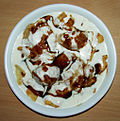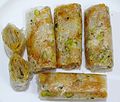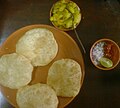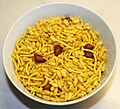| Name | Image | Description |
|---|
| Pakora |  | Created by taking one or two ingredients such as onion, eggplant, potato, spinach, plantain, paneer, cauliflower, tomato, chili pepper, or occasionally apple [36] or chicken and dipping them in a batter of gram flour, they are then deep-fried. The most popular varieties are palak pakora, made from spinach, paneer pakora, made from paneer (soft cheese), pyaz pakora, made from onion, and aloo pakora, made from potato. |
| Pakwan |  | Crisp snacks |
| Palappam |  | A Nasrani dish of fermented bread made with rice batter and coconut milk, hence the name palappam (meaning milk bread). It is a staple food and a cultural synonym of the Nasranis of Kerala in coastal south west India. The rice batter for palappam is made on a stone griddle and coconut milk with toddy is used for fermentation. The toddy used for fermentation of the milk bread or palappam yields it the name kallappam, (kall means toddy), while the rice batter and coconut milk gives a white colour to it, yielding the name vellayappam or white bread. The palappam is prepared in an appa kal (mould) and looks like a pancake. |
| Paneer tikka |  | Made from chunks of paneer marinated in spices and grilled in a tandoor, [37] [38] it is a lacto-vegetarian alternative to chicken tikka and other meat dishes. [39] [40] [41] It is a popular dish that is widely available in India and other countries with an Indian diaspora. [42] [43] |
| Panipuri |  | A popular street snack in India, Pakistan, Bangladesh, Sri Lanka, and Nepal, it consists of a round, hollow puri , fried crisp and filled with a mixture of flavored water (pani), tamarind chutney, chili, chaat masala , potato, onion, and chickpeas. It is generally small enough to fit completely into one's mouth. It is a popular street food dish in Mumbai, Delhi, Karachi, Lahore, Dhaka, Kolkata, and Kathmandu. |
| Papadam or Papad |  | A thin, crisp Indian preparation sometimes described as a cracker, it is typically served as an accompaniment to a meal in India. It is also eaten as an appetizer or a snack, and can be eaten with various toppings such as chopped onions, chutney, or other dips and condiments. |
| Papri chaat |  | An Indian fast food, chaat , an Indo-Aryan word which literally means "lick", is used to describe a range of snacks and fast-food dishes; papri refers to crisp fried dough wafers made from refined white flour and oil. In papri chaat, the papris are served with boiled potatoes, boiled chick peas, chilis, yogurt, and tamarind chutney and topped with chaat masala and sev. Also found in Pakistan |
| Paratha |  | A flatbread that originated in the Indian subcontinent in the Indian state of Punjab, paratha is an amalgamation of the words parat and atta , which literally means layers of cooked dough. [44] The paratha dough usually contains ghee or cooking oil which is also layered on the freshly prepared paratha. [45] Parathas are usually stuffed with vegetables such as boiled potatoes (as in aloo ka paratha), leaf vegetables, radishes or cauliflower or paneer (South Asian cheese). Also common in Pakistan. |
| Parotta |  | One of the most popular unleavened flat breads in Punjabi North Indian cuisine and South Indian cuisine, it is made by pan frying whole wheat dough on a tava . [46] Also common in Pakistan. |
| Pav Bhaji |  | A Maharashtrian fast food dish that originated in Maharashtrain cuisine, it is native to Maharashtra and has now become popular in most metropolitan areas in India, especially in those of central and western Indian states [47] such as Gujarat and Karnataka. [48] Pav in Marathi means a small loaf of bread. Bhaji in Marathi means vegetable dish. Pav bhaji consists of bhaji (a thick potato-based curry) garnished with coriander, chopped onion, and a dash of lemon and lightly toasted pav. The pav is usually buttered on all sides. |
| Piyaju |  | |
| Pohe (Maharashtrian) |  | An Indian fast food prepared in Maharashtra and some Northern States. Northern variants of this dish tend to be sweet, while Maharashtrian pohay tends to be spicy. It is also often served with an extremely spicy curry, locally called 'tarri'. Pohay with tarri is a relished snack in the Vidharbha region of Maharashtra state. Pohay is made of flattened, processed rice, roasted with chili peppers, onions, mustard and cumin seeds and curry leaves (called Kadi-patta).An easily digestible, dehusked rice which is flattened into flat light dry flakes. These flakes of rice swell when added to liquid, whether hot or cold, as they absorb water, milk or any other liquids. The thicknesses of these flakes vary between almost translucently thin (the more expensive varieties) to nearly four times thicker than a normal rice grain. [49] |
| Ponganalu |  | |
| Poornalu |  | A traditional sweet in the Telugu festivals. It is made of rice flour stuffed with jaggery mixed dal paste and dry fruits. It is often served hot with ghee. It is called Poornalu in the Andhra region. |
| Pootharekulu |  | Pootharekulu is a popular sweet from Atreyapuram, East Godavari, India. 'Pootha' is coating and 'Reku' (plural Rekulu) is sheet in Telugu. Pootharekulu are also known as ‘Paper sweets’ as they give the appearance of folded paper. It is made from a particular rice batter called jaya biyyam (biyyam means rice), powdered sugar and ghee (clarified butter). |
| Potato chips |  | A thin slice of potato that is deep fried or baked until crunchy. |
| Puffed rice |  | A type of puffed grain made from rice; usually made by heating rice kernels under high pressure in the presence of steam, though the method of manufacture varies widely. Pori (Puffed Rice) has been mentioned in various. In Gujarat it is called as Mamra (મમરા), Tamil literatures as an offering to Hindu deities. Offerings of pori and jaggery made to Vinayagar (Lord Ganesh) are mentioned in the Tiruppugazh, a 15th-century anthology of Tamil religious songs, written by Tamil poet Arunagirinathar. Pori is offered to Hindu gods and goddesses in all poojas in the South Indian states of Kerala and Tamil Nadu. |
| Puffs |  | vegetarian puffs are made with potatoes,carrots,paneer.Egg puffs and chicken puffs are also available in Indian bakeries. |
| Punugulu |  | Punukkulu is an Andhra snack and common street food in Vijayawada and few coastal districts of Andhra Pradesh. Punugulu is a deep fried snack made with rice, urad dal and other spices. They are often served with peanut chutney called as verusanaga chutney or palli chutney or Toordal chutney called as Kandhi Pachadi or they can be served with capsicum peanut chutney. |
| Puran Poli |  | A traditional type of sweet flatbread made in India in the states of Maharashtra, Karnataka, Gujarat, andhra pradesh and Goa. [50] It is a major part of Maharastrian cuisine and is generally made during festivals and special occasions |
| Puri |  | Eaten for breakfast or as a snack or light meal, puri is prepared with wheat flour, either atta (whole wheat flour), maida (refined wheat flour), or sooji (coarse wheat flour). A dough of flour and salt is either rolled out in a small circle or rolled out and cut out in small circles and deep fried in ghee or vegetable oil. While deep frying, it puffs up like a round ball because moisture in the dough changes into steam which expands in all directions. When it is golden-brown in color, it is removed and may be served hot or saved for later use (as with the snack food pani puri). |
| Puri bhaji |  | An Indian dish made up of puri and aloo bhaji. The puris are made up of flat rounds of flour which are deep fried, served with a spiced potato dish which could be dry or curried. [51] It is a traditional breakfast dish in North India. [52] |















































































































